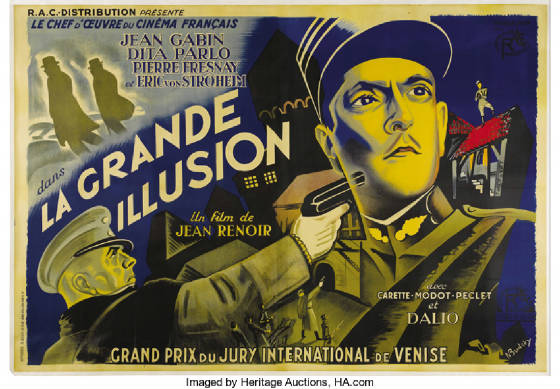|
|
 |
|

(1937, directed by Jean Renoir)
- inducted 2018 –
“Based on the experiences of a flyer he knew during the war, Renoir’s La Grande Illusion is unquestionably
one of the masterpieces of the silver screen, a film of incredible humanity set during a period of great inhumanity. In short,
it’s probably the greatest anti-war film ever made (for me a flat footed tie in that regard with Milestone's All
Quiet on the Western Front), a film that cannot help but move people every time they see it.
“During World War I German flyer Von Rauffenstein accepts some captured French pilots at his squadron prior to their
being sent on to POW camps. He entertains them most civilly, as befits a career officer of the upper classes. The men then
go on to the POW camp where they are involved in a morale-boosting revue and nearly successfully digging out a tunnel, before
a transfer to a medieval fortress which is commanded by none other than Von Rauffenstein, who has since suffered a nearly
paralyzing injury and has been retired to being ‘a mere policeman.’ Though he again treats them with the utmost
civility, his duty is to prevent them escaping; theirs is to escape.
“La Grande Illusion is one of two Renoir mega-masterpieces (with La Règle de Jeu) and it is singularly
awe-inspiring. Through a combination of authenticity of vision, a perfect script, suitably war-torn settings and a host of
fine performances, the director conjures up an image of what might be called the last hurrah of the lost generation. Opposing
career officers Von Rauffenstein and Boeldieu, aristocratic enough to speak three languages fluently, meet to discuss the
dimming of their society by the war. The German carries on, spinal injuries and metal skull plates and all, to ‘give
the illusion of serving my country.’ Is this illusion of patriotism the ‘grand illusion’ of the title, or
is it rather the illusion of class divide? Men may be from different classes and nationalities, but they remain men, whether
they sing ‘Watch on the Rhine’, ‘La Marseillaise’ or ‘It’s a Long Way to Tipperary’
(as they do at one point or another). Even race and religion do not matter, with Rosenthal the Jew the most generous of the
bunch in his feeding of the entire group from his deluxe hampers (chicken, pâte de fois gras, Périgord truffles, etc.). The
atmosphere of war removes class to the point where it no longer matters. When one of the prisoners observes ‘man truly
is an adaptable animal,’ he’s speaking truer than he realizes.
“As for Renoir’s collaborators, though Kosma’s fateful score and the look of the film are memorable, it’s
the cast one recalls. The supports read like a who’s who of French character actors of the day; Julien Carette, Gaston
Modot, Marcel Dalio (maybe Harry Baur and Louis Jouvet were out to lunch), with particular praise to Dalio. Yet it’s
the three stars who shine brightest; Gabin is quite superb as the salt of the earth Marechal who comes to love a German woman
in the epilogue and learns the true meaning of sacrifice, Fresnay is superbly dry as the aloof but good-hearted Boeldieu who
determines to die gloriously rather than die with his class.
“But the most unforgettable performance of all is from Von Stroheim, the prototype stick-necked Prussian humanist even
before the accident. For them and for Renoir this is a film to cherish again and again, a film which shows you how the smallest
symbolic gesture may be worth a fortune, be it Boeldieu’s white gloves, Von Rauffenstein’s geranium (my favorite
image in the film) or Marechal’s learning about Lotte’s blaueaugen. In the end, all we can do is drink
to Von Stroheim’s toast, ‘may the earth lie gently on our gallant enemy.’ Gentlemanly warfare is long gone
but it flourished in a film destined for the ages.
~ Sam Juliano
|
 |
|
Original title: La Grande Illusion
Principal cast: Jean Gabin, Dita Parlo, Pierre Fresnay, Erich von Stroheim, Julien Carette, Georges Péclet, Werner Florian,
Jean Dasté, Sylvain Itkine, Gaston Modot, Marcel Dalio, with uncredited appearance by Jacques Becker
Screenplay by: Charles Spaak and Jean Renoir (scenario and dialogue)
Cinematography by: Christian Matras
Production design by: Eugène Lourié
Costume design by: René Decrais
Film editing by: Marthe Huguet, Renée Lichtig, Marguerite Renoir
Original music by: Joseph Kosma
Makeup by: Raffels
Sound by: Joseph de Bretagne (sound engineer)
Produced by: Albert Pinkovitch, Frank Rollmer (both uncredited)
France
Duration: 113 minutes
Languages: French, German, English, Russian
Filmed in black and white
Sound mix: Mono (Western Electric Sound System)
Aspect ratio: 1.37:1
Produced by Réalisation d’Art Cinématographique
Released in USA by World Pictures Corporation
Premiered in France on June 4, 1937
USA release date: September 12, 1938
Awards and honors:
- Selected as one of Roger Ebert’s “Great Movies,” 3 October 1999
- Venice, 1937: Best Overall Artistic Contribution (won)
- NYFCC Awards, 1938: Best Foreign Language Film (won)
- National Board of Review, 1938: Best Foreign Film (won)
- National Board of Review, 1938: Best Acting (won)
- Academy Awards (USA), 1938: Best Picture (nominated)
|
 |
|
|
 |
|
|
 |
|
|
|
|
|
|
 |

